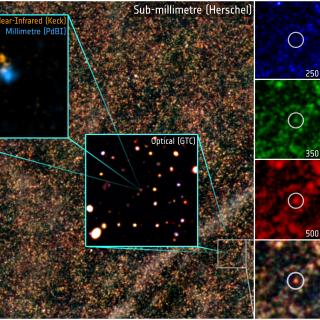Bibcode
Berta, S.; Young, A. J.; Cox, P.; Neri, R.; Jones, B. M.; Baker, A. J.; Omont, A.; Dunne, L.; Carnero Rosell, A.; Marchetti, L.; Negrello, M.; Yang, C.; Riechers, D. A.; Dannerbauer, H.; Perez-Fournon, I.; van der Werf, P.; Bakx, T.; Ivison, R. J.; Beelen, A.; Buat, V.; Cooray, A.; Cortzen, I.; Dye, S.; Eales, S.; Gavazzi, R.; Harris, A. I.; Herrera, C. N.; Hughes, D.; Jin, S.; Krips, M.; Lagache, G.; Lehnert, M.; Messias, H.; Serjeant, S.; Stanley, F.; Urquhart, S.; Vlahakis, C.; Weiß, A.
Referencia bibliográfica
Astronomy and Astrophysics
Fecha de publicación:
2
2021
Revista
Número de citas
32
Número de citas referidas
30
Descripción
Exploiting the sensitivity of the IRAM NOrthern Extended Millimeter Array (NOEMA) and its ability to process large instantaneous bandwidths, we have studied the morphology and other properties of the molecular gas and dust in the star forming galaxy, H-ATLAS J131611.5+281219 (HerBS-89a), at z = 2.95. High angular resolution (0.″3) images reveal a partial 1.″0 diameter Einstein ring in the dust continuum emission and the molecular emission lines of 12CO(9-8) and H2O(202 - 111). Together with lower angular resolution (0.″6) images, we report the detection of a series of molecular lines including the three fundamental transitions of the molecular ion OH+, namely (11 - 01), (12 - 01), and (10 - 01), seen in absorption; the molecular ion CH+(1 - 0) seen in absorption, and tentatively in emission; two transitions of amidogen (NH2), namely (202 - 111) and (220 - 211) seen in emission; and HCN(11 - 10) and/or NH(12 - 01) seen in absorption. The NOEMA data are complemented with Very Large Array data tracing the 12CO(1 - 0) emission line, which provides a measurement of the total mass of molecular gas and an anchor for a CO excitation analysis. In addition, we present Hubble Space Telescope imaging that reveals the foreground lensing galaxy in the near-infrared (1.15 μm). Together with photometric data from the Gran Telescopio Canarias, we derive a photometric redshift of zphot = 0.9-0.5+0.3 for the foreground lensing galaxy. Modeling the lensing of HerBS-89a, we reconstruct the dust continuum (magnified by a factor μ ≃ 5.0) and molecular emission lines (magnified by μ ∼ 4 - 5) in the source plane, which probe scales of ∼0.″1 (or 800 pc). The 12CO(9 - 8) and H2O(202 - 111) emission lines have comparable spatial and kinematic distributions; the source-plane reconstructions do not clearly distinguish between a one-component and a two-component scenario, but the latter, which reveals two compact rotating components with sizes of ≈1 kpc that are likely merging, more naturally accounts for the broad line widths observed in HerBS-89a. In the core of HerBS-89a, very dense gas with nH2 ∼ 107 - 9 cm-3 is revealed by the NH2 emission lines and the possible HCN(11 - 10) absorption line. HerBS-89a is a powerful star forming galaxy with a molecular gas mass of Mmol = (2.1 ± 0.4) × 1011 M⊙, an infrared luminosity of LIR = (4.6 ± 0.4) × 1012 L⊙, and a dust mass of Mdust = (2.6 ± 0.2) × 109 M⊙, yielding a dust-to-gas ratio δGDR ≈ 80. We derive a star formation rate SFR = 614 ± 59 M⊙ yr-1 and a depletion timescale τdepl = (3.4 ± 1.0) × 108 years. The OH+ and CH+ absorption lines, which trace low (∼100 cm-3) density molecular gas, all have their main velocity component red-shifted by ΔV ∼ 100 km s-1 relative to the global CO reservoir. We argue that these absorption lines trace a rare example of gas inflow toward the center of a galaxy, indicating that HerBS-89a is accreting gas from its surroundings.
The reduced datacubes are only available at the CDS via anonymous ftp to http://cdsarc.u-strasbg.fr (ftp://130.79.128.5) or via http://cdsarc.u-strasbg.fr/viz-bin/cat/J/A+A/646/A122
Proyectos relacionados

Formación y Evolución de Galaxias: Observaciones Infrarrojas y en otras Longitudes de Onda
Este grupo desarrolla varios proyectos extragalácticos en diferentes rangos del espectro electromagnético utilizando satélites y telescopios en tierra para estudiar la evolución cosmológica de las galaxias y el origen de la actividad nuclear en galaxias activas. En el aspecto instrumental, el grupo forma parte del consorcio internacional que ha
Ismael
Pérez Fournon

Gas Molecular y Polvo en Galacias através del Tiempo Cósmico
Dos cuestiones fundamentales en la Astrofísica son la conversión de gas molecuar en estrellas y cómo este proceso físico depende del entorno en todas las escalas, desde sistemas planetarios, cúmulos estelares, galaxias hasta cúmulos de galaxias. El objectivo principal de este proyecto es el de estudiar la formación y evolución de galaxias a partir
Helmut
Dannerbauer